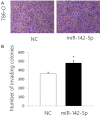MicroRNA-142-5p promotes cell growth and migration in renal cell carcinoma by targeting BTG3
- PMID: 28559989
- PMCID: PMC5446521
MicroRNA-142-5p promotes cell growth and migration in renal cell carcinoma by targeting BTG3
Abstract
Purpose: Some microRNA (miRNA) levels have been found to be dysregulated in cancer patients, suggesting the potential usefulness of miRNAs in cancer therapies. The purpose of this study was to investigate the expression of miR-142-5p in human renal cell carcinoma (RCC) and its potential role in tumor growth and metastasis.
Methods: The expression level of miR-142-5p in human RCC tissue and cell lines was determined by quantitative reverse transcription polymerase chain reaction analysis. MTT, colony formation, Transwell, and cell cycle assays were performed to explore the potential functions of miR-142-5p in human RCC cells. The potential target gene of miR-142-5p was identified and confirmed via luciferase reporter assays.
Results: miR-142-5p expression was elevated in RCC tissues and cell lines. Overexpression of miR-142-5p significantly promoted cell proliferation and colony formation and could prevent G1 phase arrest among RCC 786-O cells. Meanwhile, the migration potential of 786-O cells was greater than that of control cells. BTG3 was identified as a direct target of miR-142-5p, and re-expression of BTG3 reversed the miR-142-5p-induced cell proliferation.
Conclusion: miR-142-5p promoted the proliferation and migration of RCC cells by targeting BTG3. With this potential onco-miRNA role in the progression of RCC, miR-142-5p may be a therapeutic target for the treatment of RCC.
Keywords: BTG3; miR-142-5p; proliferation; renal cell carcinoma.
Conflict of interest statement
None.
Figures





Similar articles
-
Regulation of BTG3 by microRNA-20b-5p in non-small cell lung cancer.Oncol Lett. 2019 Jul;18(1):137-144. doi: 10.3892/ol.2019.10333. Epub 2019 May 7. Oncol Lett. 2019. PMID: 31289482 Free PMC article.
-
MicroRNA-142-5p promotes the proliferation and metastasis of nasopharyngeal carcinoma.Nucleosides Nucleotides Nucleic Acids. 2023;42(8):657-670. doi: 10.1080/15257770.2023.2182887. Epub 2023 Mar 17. Nucleosides Nucleotides Nucleic Acids. 2023. PMID: 36929702
-
MiR-106b-5p Promotes Proliferation and Inhibits Apoptosis by Regulating BTG3 in Non-Small Cell Lung Cancer.Cell Physiol Biochem. 2017;44(4):1545-1558. doi: 10.1159/000485650. Epub 2017 Dec 4. Cell Physiol Biochem. 2017. PMID: 29197876
-
Tumor suppressor miR-211-5p is associated with cellular migration, proliferation and apoptosis in renal cell carcinoma.Exp Ther Med. 2018 Apr;15(4):4019-4028. doi: 10.3892/etm.2018.5908. Epub 2018 Feb 28. Exp Ther Med. 2018. PMID: 29581751 Free PMC article.
-
Evaluation of Urinary miRNA in Renal Cell Carcinoma: A Systematic Review.Cancers (Basel). 2025 Apr 16;17(8):1336. doi: 10.3390/cancers17081336. Cancers (Basel). 2025. PMID: 40282512 Free PMC article. Review.
Cited by
-
Circ_0000020 elevates the expression of PIK3CA and facilitates the malignant phenotypes of glioma cells via targeting miR-142-5p.Cancer Cell Int. 2021 Jan 28;21(1):79. doi: 10.1186/s12935-021-01767-5. Cancer Cell Int. 2021. PMID: 33509213 Free PMC article.
-
The clinicopathological significances and related signal pathways of BTG3 mRNA expression in cancers: A bioinformatics analysis.Front Genet. 2022 Sep 16;13:1006582. doi: 10.3389/fgene.2022.1006582. eCollection 2022. Front Genet. 2022. PMID: 36186486 Free PMC article.
-
Semen miRNAs Contained in Exosomes as Non-Invasive Biomarkers for Prostate Cancer Diagnosis.Sci Rep. 2019 Sep 24;9(1):13772. doi: 10.1038/s41598-019-50172-6. Sci Rep. 2019. PMID: 31551516 Free PMC article.
-
MiR-142-5p Acts as a Significant Regulator Through Promoting Proliferation, Invasion, and Migration in Breast Cancer Modulated by Targeting SORBS1.Technol Cancer Res Treat. 2019 Jan-Dec;18:1533033819892264. doi: 10.1177/1533033819892264. Technol Cancer Res Treat. 2019. PMID: 31789129 Free PMC article.
-
FAM98A promotes cancer progression in endometrial carcinoma.Mol Cell Biochem. 2019 Sep;459(1-2):131-139. doi: 10.1007/s11010-019-03556-1. Epub 2019 May 21. Mol Cell Biochem. 2019. PMID: 31114934
References
-
- Guo J, Ma J, Sun Y, Qin S, Ye D, Zhou F, He Z, Sheng X, Bi F, Cao D, Chen Y, Huang Y, Liang H, Liang J, Liu J, Liu W, Pan Y, Shu Y, Song X, Wang W, Wang X, Wu X, Xie X, Yao X, Yu S, Zhang Y, Zhou A. Chinese guidelines on the management of renal cell carcinoma (2015 edition) Ann Transl Med. 2015;3:279. - PMC - PubMed
-
- Motzer RJ, Bacik J, Mariani T, Russo P, Mazumdar M, Reuter V. Treatment outcome and survival associated with metastatic renal cell carcinoma of non-clear-cell histology. J. Clin. Oncol. 2002;20:2376–2381. - PubMed
-
- Lam JS, Shvarts O, Leppert JT, Figlin RA, Belldegrun AS. Renal cell carcinoma 2005: new frontiers in staging, prognostication and targeted molecular therapy. J Urol. 2005;173:1853–1862. - PubMed
-
- Capitanio U, Montorsi F. Renal cancer. Lancet. 2016;387:894–906. - PubMed
LinkOut - more resources
Full Text Sources
Other Literature Sources
